|
|
 |
|
January 25, 2010
 A number of colleagues questioned my sanity when I announced plans for another wine competition. The Winemaker Challenge would be my fifth competition, and I was launching it in the midst of a stubborn economic downturn. A number of colleagues questioned my sanity when I announced plans for another wine competition. The Winemaker Challenge would be my fifth competition, and I was launching it in the midst of a stubborn economic downturn.
It was a bit of a white-knuckle ride, but the debut Winemaker Challenge attracted nearly 800 entries from around the globe, giving my 18 winemaker judges plenty to chew on after they arrived in San Diego last week for the tasting evaluations.
The judges were in good form and the tastings went well, making the new event a great success in its first year. The winemakers also turned out to be generous in their assessments, medaling better than 50 percent of the wines entered.
Gloria Ferrer's 2002 Royal Cuvee Brut ($35) came away with the top prize, winning a unanimous vote as the very first Wine of the Year at the very first Winemaker Challenge.
Chateau Ste. Michelle's 2008 Dry Riesling ($12) was voted Best of Show White; Napa Valley winery Andretti took Best of Show Red with its 2007 Syrah ($41); Temecula's Falkner Winery had Best of Show Rose with its 2008 Rosato ($15); and the 2008 Inniskillin Riesling Ice Wine ($80) from Niagara Peninsula collected Best of Show Dessert.
Gloria Ferrer's Royal Cuvee was also Best of Show Sparkling, of course.
Click here for complete results.
Posted by Robert Whitley at 12:17 PM
|
|
January 19, 2010
In my Creators Syndicate Wine Talk column this week I tackle value wineries. The emphasis is mine because my take on value might be considered somewhat out of the mainstream. I refuse to draw a dollar-line in the sand.
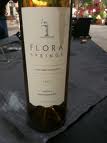 Even if I have an arbitrary limit of, say, $18 for a red and $15 for a white, I am willing to spend a bit more if I believe I'm getting a bang for the extra bucks. Value isn't necessarily a synonym for cheap. Nor should it be. Even if I have an arbitrary limit of, say, $18 for a red and $15 for a white, I am willing to spend a bit more if I believe I'm getting a bang for the extra bucks. Value isn't necessarily a synonym for cheap. Nor should it be.
So this week's Wine Talk lists my Top 25 "Value" wineries from around the world. These are wineries that have impressed me over the past year, but as always the list is subject to change and will be updated as warranted over the course of this year.
I've posted the first five of the Top 25 here, but the entire list can be accessed over at Whitley On Wine.
1. Flora Springs, Napa Valley -- No fair, you might think, because I lead off with perhaps the most expensive wines in the Top 25. Yet, the $26 price tag on the 2006 Flora Springs Cabernet Sauvignon this week was truly remarkable. Think about that. A solid Napa Valley Cabernet Sauvignon from a big-time Napa winery for under $30. A few years back the regular Napa Valley Cab from Flora Springs very nearly won the award for best red wine at the Critics Challenge International Wine Competition. Enough said.
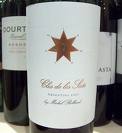 2. Clos de los Siete, Mendoza, Argentina -- The great French winemaker Michel Rolland makes these wines, and they retail for less than $20. I'd put Clos de los Siete up against any $50 Napa red any day of the week. Might not win, but it wouldn't be outclassed. 2. Clos de los Siete, Mendoza, Argentina -- The great French winemaker Michel Rolland makes these wines, and they retail for less than $20. I'd put Clos de los Siete up against any $50 Napa red any day of the week. Might not win, but it wouldn't be outclassed.
3. Truchard, Napa Valley -- These guys grow their own grapes (selling much of it to other wineries that proudly tout the Truchard vineyard) in Napa's Carneros district and make a handful of superb wines that retail in the $18 to $30 range, including dynamite Syrah, Merlot, Chardonnay and Roussanne.
4. Castello Monaci, Puglia, Italy -- Recently refurbished vineyards are yielding exceptional Primitivo and Negroamaro near the southern Italian village of Salice Salentino. Except for the aggressively priced Primitivo Artas, all of the Monaci reds retail in the $13 range. Considering they mostly score 90 points or better when evaluated, these wines represent incredible value on anybody's scale.
 5. Ca' del Solo, Monterey County -- This is for all intents and purposes Bonny Doon Vineyards, and the Syrah at around $15 is one of the finest produced in the United States. I could say the same thing about the Albarino, but I hate to keep repeating myself! 5. Ca' del Solo, Monterey County -- This is for all intents and purposes Bonny Doon Vineyards, and the Syrah at around $15 is one of the finest produced in the United States. I could say the same thing about the Albarino, but I hate to keep repeating myself!
Posted by Robert Whitley at 1:53 PM
|
|
January 6, 2010
Global warming, carbon footprints, greenhouse gases, higher concentrations of ground level ozone, hotter and longer heat waves, land degradation, habitat destruction--the list of environmental concerns goes on and on. But I’d rather start 2010 in the spirit of hope rather than despair, so while saluting all the winegrowers in the world who are adopting greener viticultural practices I’m selecting the Mendocino Wine Company--one of California’s most innovative, dedicated and eco-friendly wine producers--as my winery of the year.
Mendocino Wine Company was formed in 2004, when Paul Dolan and his partners acquired Parducci Cellars, Mendocino’s oldest winery 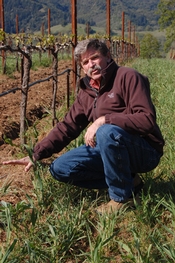 (founded in 1932). Dolan, a pioneering producer of premium ecologically oriented wines, first gained attention during his three decades at Fetzer Vineyards, where he was winemaker, then president. Convinced that sustainability is, in his words, “a continuous journey rather than a temporary trend,” Dolan has steered the Mendocino Wine Company in directions that emphasize the health of the land which, in turn, affects the style, structure and flavor of his wines. The number of ways the Mendocino Wine Company has gone green include sourcing grapes from family farms, emphasizing renewable energy by the use of biodiesel vegetable oil-based fuel in their tractors and cars, and using solar power to supply 25% of their energy needs. Parducci, became the nation’s first carbon neutral winery in 2007. The Mendocino Wine Company produces several different labels (all made at the same winery in Mendocino) including Big Yellow, Roselle, and Tusk’n Red. Although I’ve not had the opportunity to taste most of these wines, I am familiar with, and can whole heartedly recommend both the Paul Dolan and the Parducci labels. These are serious and distinctive wines, made with integrity, and reflecting a profound sense of place. They are also surprisingly affordable given the overall high quality of the wines--try the Paul Dolan Chardonnay and Sauvignon Blanc, for example, each $17.99, and Parducci’s Pinot Grigio, Merlot or terrific Petite Sirah, $10.99 each. (founded in 1932). Dolan, a pioneering producer of premium ecologically oriented wines, first gained attention during his three decades at Fetzer Vineyards, where he was winemaker, then president. Convinced that sustainability is, in his words, “a continuous journey rather than a temporary trend,” Dolan has steered the Mendocino Wine Company in directions that emphasize the health of the land which, in turn, affects the style, structure and flavor of his wines. The number of ways the Mendocino Wine Company has gone green include sourcing grapes from family farms, emphasizing renewable energy by the use of biodiesel vegetable oil-based fuel in their tractors and cars, and using solar power to supply 25% of their energy needs. Parducci, became the nation’s first carbon neutral winery in 2007. The Mendocino Wine Company produces several different labels (all made at the same winery in Mendocino) including Big Yellow, Roselle, and Tusk’n Red. Although I’ve not had the opportunity to taste most of these wines, I am familiar with, and can whole heartedly recommend both the Paul Dolan and the Parducci labels. These are serious and distinctive wines, made with integrity, and reflecting a profound sense of place. They are also surprisingly affordable given the overall high quality of the wines--try the Paul Dolan Chardonnay and Sauvignon Blanc, for example, each $17.99, and Parducci’s Pinot Grigio, Merlot or terrific Petite Sirah, $10.99 each.
Continuing in the spirit of hope (not to be confused with optimism) for the planet, I’m singling out Drappier Brut Nature as my wine of the year. You’ll find the Drappier Champagne house far off the beaten track, in the Aube southern section of the Champagne region, almost on the Burgundy border. The Drappier family has had its roots in Champagne cultivation here since the 17th century. The prestige vintages are housed in magnificent 12th century vaulted cellars once owned by the Cistercian monks (this is one of the only medieval Champagne cellars still left). Fifty-one year old Michel Drappier, who heads the company today, is both heir to one of the most traditional wine estates in the world, and one of the most innovative vintners around. In addition to moving into sustainable agriculture in the vineyards, he has instituted new procedures in the winery, including reducing the amount of sulfur used in the winemaking process. Excess sulfur, he believes, can be harmful to the health of both consumers and winery workers, and it can also mute the fullest potential expression of a wine’s natural qualities. “I am fiercely against the excessive use of sulfur. We use less than any Champagne house I know of,” he told me recently. Drappier’s goal is to be the first to release an entirely sulfur-free Champagne. Whether it’s the results of Michel Drappier’s winemaking philosophy, or of the particular Aube terroir, or those ancient chalky cellars--or all of the above--I am crazy about all Drappier Champagnes. The fragrant and intense rosé, for example, is marvelously fragrant and intricate, and the Carte d’Or manages to be 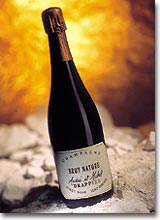 both supple and invigorating. But it is the Brut Nature that I’m singling out here, both for its deliciousness and its uniqueness. Unlike most Champagnes, this one has been given no liqueur d’expedition—the dash of sugared liqueur that traditionally tops off Champagne--and although not everyone will love the stunningly brut results, I am utterly seduced by the juxtaposition of bone dry minerality and emphatic fruitiness. Add to this the wine’s extraordinary vivacity, its tiny zingy bubbles, and its purity of flavors and you might well conclude that this is one of those Champagnes that will set you back hundreds of dollars instead of less than $50. With wine like this in my flute, I’m ready to face 2010. Champagne Drappier NV Brut Nature is $49, the Rosé is also $49, and the Carte d’Or NV is $39. both supple and invigorating. But it is the Brut Nature that I’m singling out here, both for its deliciousness and its uniqueness. Unlike most Champagnes, this one has been given no liqueur d’expedition—the dash of sugared liqueur that traditionally tops off Champagne--and although not everyone will love the stunningly brut results, I am utterly seduced by the juxtaposition of bone dry minerality and emphatic fruitiness. Add to this the wine’s extraordinary vivacity, its tiny zingy bubbles, and its purity of flavors and you might well conclude that this is one of those Champagnes that will set you back hundreds of dollars instead of less than $50. With wine like this in my flute, I’m ready to face 2010. Champagne Drappier NV Brut Nature is $49, the Rosé is also $49, and the Carte d’Or NV is $39.
Posted by Marguerite Thomas at 9:09 AM
|
|
January 1, 2010
My criteria for selecting a winery of the year are pretty straightforward--if rather numerous: The wines need to be delicious, fairly-priced, food-friendly, reasonably widely-available, consistent across the entire line of products, true to their place of origin, respectful of local grape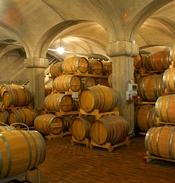 traditions, and marked by a distinctiveness of character and style. traditions, and marked by a distinctiveness of character and style.
That’s a lot to ask of a winery, and only a few manage to answer the call in any given year. Nevertheless, there are always a few rather than just one. So, to select an ultimate winner, I rely on another, rather less tangible criterion: Coherent complexity.
If you don’t immediately know what I mean by this, you can taste what it means by trying a wine from my top winery for 2009, Terradora Dipaolo from Campania in southern Italy.  Terradora produces an entire line of wines that stand as object lessons in coherent complexity. Whether white or red, the current releases are intricate and nuanced, with multiple aromas, flavors and textural elements. At the same time, all of these distinct sensory signals are symmetrical in their prominence relative to one another, producing an overall experience of a coherent whole that is greater than the sum of its parts. Terradora produces an entire line of wines that stand as object lessons in coherent complexity. Whether white or red, the current releases are intricate and nuanced, with multiple aromas, flavors and textural elements. At the same time, all of these distinct sensory signals are symmetrical in their prominence relative to one another, producing an overall experience of a coherent whole that is greater than the sum of its parts.
Terradora’s reds are terrific and the whites are arguably even better (as a group, I thought them the best Biancos I tasted from anyone in Italy in 2009). Three white wines to look for are 2008 vintage Falanghina ($18), Greco di Tufo ($25) and Fiano di Avellino ($29). Ttwo excellent reds are 2008 Campania IGT Aglianico and 2003 Taurasi. These aren’t cheap, but they offer very good value for the money, and are fairly widely available through Vias Imports. With these wines, tasting is believing--instantly.
With economic conditions still so fragile around the world, I want to recognize two wines this year, one priced under $20 and one without regard to cost.
Maquis, Colchagua Valley (Chile) “Lien” 2006 ($19, Global Vineyard Importers): Chile has demonstrated its ability to produce a few amazing high-end wines. It is also a reliable source for many good bottlings at affordable prices. However, the key to Chile’s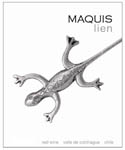 future success will lie in making truly excellent wines at moderate price points, and this wine is an almost perfect embodiment of that aspiration. A blend of 42% Syrah, 30% Carmenère, 12% Cabernet Franc, 9% Petit Verdot and 7% Malbec, it is a phenomenal over-achiever showing the complexity, texture and overall class of a much more expensive wine. I’ve tasted it three times during the year and came away more impressed in each instance. The last time around, I kept the bottle open for three days, and the wine showed nothing but improvement over that span, which defies belief for a wine priced under $20. Wonderful now with food, it is likely to develop (i.e., not just last, but actually improve) for up to a decade. Ricardo Rivadeneira Hurtado and his French consultant, Xavier Choné are achieving something important in the Colchagua Valley, and you’d be wise to taste it while it is still such a bargain. future success will lie in making truly excellent wines at moderate price points, and this wine is an almost perfect embodiment of that aspiration. A blend of 42% Syrah, 30% Carmenère, 12% Cabernet Franc, 9% Petit Verdot and 7% Malbec, it is a phenomenal over-achiever showing the complexity, texture and overall class of a much more expensive wine. I’ve tasted it three times during the year and came away more impressed in each instance. The last time around, I kept the bottle open for three days, and the wine showed nothing but improvement over that span, which defies belief for a wine priced under $20. Wonderful now with food, it is likely to develop (i.e., not just last, but actually improve) for up to a decade. Ricardo Rivadeneira Hurtado and his French consultant, Xavier Choné are achieving something important in the Colchagua Valley, and you’d be wise to taste it while it is still such a bargain.
Bodegas Dios Baco, Oloroso Sherry “Baco Imperial” 30 Year-Old NV ($100, CIV USA): Sherry isn’t the easiest wine to sell at any price, 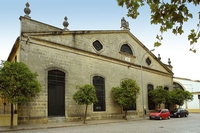 and I admit that I wouldn’t want to have to pay the rent by selling $100 bottles of it. Nevertheless, this was probably the single best wine that I’ve tasted in 2009. It is phenomenally intricate and yet perfectly balanced. The aromas, palate flavors and finish are all intensely expressive, but the wine is so finely integrated after 30 years of maturation that there’s a symphonic impression to it, and the “orchestra” was having an extremely good night on each of the three nights when I evaluated it. Rich, concentrated and very deeply flavored, it is nevertheless dry and brilliantly infused with fresh acidity that keeps the wine from ever seeming heavy or ponderous. Each sip delivers a welter of rich, intense flavors, with notes that tail off very slowly and in perfect symmetry, so that the ensemble of flavors is decreasingly intense but essentially identical for a full 30 seconds after the wine has been swallowed. If you want to exchange some holiday gift money in return for a riveting wine experience, this is the ticket. and I admit that I wouldn’t want to have to pay the rent by selling $100 bottles of it. Nevertheless, this was probably the single best wine that I’ve tasted in 2009. It is phenomenally intricate and yet perfectly balanced. The aromas, palate flavors and finish are all intensely expressive, but the wine is so finely integrated after 30 years of maturation that there’s a symphonic impression to it, and the “orchestra” was having an extremely good night on each of the three nights when I evaluated it. Rich, concentrated and very deeply flavored, it is nevertheless dry and brilliantly infused with fresh acidity that keeps the wine from ever seeming heavy or ponderous. Each sip delivers a welter of rich, intense flavors, with notes that tail off very slowly and in perfect symmetry, so that the ensemble of flavors is decreasingly intense but essentially identical for a full 30 seconds after the wine has been swallowed. If you want to exchange some holiday gift money in return for a riveting wine experience, this is the ticket.
Posted by Michael Franz at 4:44 PM
|
|
 |
|